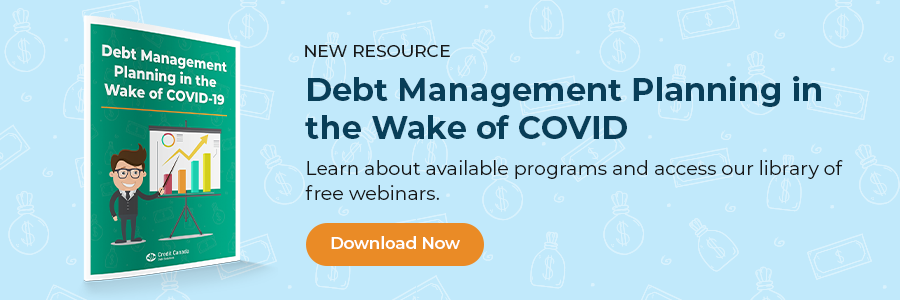
What Is a Healthy Financial Diet?
Eating your fruits and vegetables, drinking plenty of water, etc. We all know the importance of a healthy diet to stay physically and mentally fit. But what about a healthy financial diet? What does it mean to have one and what impact would better money decisions have beyond our own budgets and debt?
Ottawa-based community builder Don Monafu believes that by practicing good spending habits, Canadians can set themselves up for financial success and help the greater good.
To demonstrate this, he’s created an “Economic Nutrition Guide” that's organized by broad spending categories — everything from financial services and transportation to technology devices and books. Each category lists different options available and their broader impact on the community.
The guide provides valuable insight into how our everyday budgeting and spending are connected to social outcomes, and how we can change the way we think about how we spend our money — not just for our own benefit, such as decreasing our debt load or increasing savings, but also for the benefit of our local communities.
What Are the Impacts of Our Spending?
When Monafu set out to create his Economic Nutrition Guide, he modeled it after his own budget spreadsheet which he used to track his family's expenses every month. (You can get your own free budget planner and expense tracker here.)
In his Economic Nutrition Guide, you can easily see a direct link between individual actions (such as upcycling your clothing or buying from second-hand stores) and the resulting community impact (e.g., decreased landfill waste and increased support for charities).
For certain spending categories, the positive impact could lead to improvements for:
- People/businesses within the community
- Social engagement
- The environment
Whereas indulging in other spending categories can lead to:
- Overreliance on technology
- Environmental damage
- Chronic diseases
How Does the Economic Nutrition Guide Work?
Have you ever looked at the nutrition charts you might find at a doctor's office? Sometimes they will categorize certain types of food as "good" (such as fruits and vegetables) meaning you can eat as many as you like, while other foods should be avoided (like margarine) because they can be harmful.
Monafu’s Economic Nutrition Guide works much in the same fashion where he organizes certain expenses or spending categories under different colour banners (green, yellow, orange, and red), with green having the most positive impact (so you should choose these most often) and red having a potentially negative impact (so you should try to avoid them).
- Green: Choose Most Often
- Yellow: Choose wisely
- Orange: Limit
- Red: Avoid
Some expenses can appear under more than one colour. For example, "technology devices" shows up under green, orange, and red. That's because we have the option of repairing our device, and if that doesn't work, getting one second-hand. Both of these options are considered "green" options.
However, when it comes to technology devices, we also have the choice of limiting the number of new devices we purchase or updating the device's operating systems instead, which are both considered "orange" options.
Green: Choose Most Often
In this category, you’ll find many things you budget for already. However, you’ll also discover ways to spend less on them, all while supporting the greater good and building healthy money management habits.
For example, you can spend less on books and magazines by going to a public library, or purchasing them from an independently-owned book store or a local used bookstore. These options in turn increase community awareness, expressivity, and social health.
Other examples include:- Cell phone provider (consider local or regional cell phone providers if they're available and if they offer reliable service; otherwise, choose based on cost)
- Groceries (consider farm/meat share subscriptions to local farms, locally-owned grocery stores, or neighbourhood ethnic specialty grocery stores)
- Internet provider (consider local, not-for-profit internet service providers or independent wholesalers when possible)
- Entertainment (check out local art, theatre, and live music shows)
- Transportation (consider public transit, a bike or e-bike, locally-owned car-sharing options, or a second-hand car)
- Travel (consider staycations and locally-owned accommodations and services)
Yellow: Choose Wisely
While this category warns you to “choose wisely,” there are still ways to save money while helping the community. For example, when visiting restaurants and coffee shops, try to visit those that are independent and locally-owned to help increase social cohesion and community involvement.
Orange: Limit
With this category, Monafu highlights some purchases that are necessary but can be limited in order to save money and help the community. For example, if you need a ride somewhere and public transit isn't available you can consider locally regulated, coop-based models (i.e. coop taxis).
Red: Avoid
These are spending categories that should be avoided completely. While it may be difficult, steering clear of these types of expenses can help save money (which can then be used to pay down debt) and have a positive impact.
For example, we should consider eliminating smoking, alcohol, and sugary drinks from our budgets (as they pose considerable health risks), as well as payday lending services due to the risk of falling into an endless cycle of debt.
7 Healthy Financial Tips to Help You Save Money and Pay Down Debt
Over the years, we’ve published numerous blogs about ways to cut expenses and save money. Here are seven tips that we’ve suggested in the past that can help minimize costs, increase cash flow, and pay down debt, which go hand-in-hand with some of the categories and benefits highlighted in the Economic Nutrition Guide.
1. Use the Library
You can save some money by checking out books, movies, and magazines from your public library. Depending on how much you typically spend on entertainment and how much you can replace with content from the library, it can save you some serious money. We’re talking about $50 per month – that’s $600 each year!
And, believe it or not, most libraries have an excellent selection of books, e-books, magazines, movies, and TV shows.
The benefits don’t stop there. Many libraries also host free events, seminars, and storytime for children. And, if you have old books that you aren’t reading, many libraries accept donations which keeps them out of landfills.
2. Shop Around
Monafu recommends shopping local merchants when possible. You’re apt to find great deals, even if the items aren’t brand names, and you’ll be supporting the community. We’re written many posts about saving on groceries, so be sure to check out the following blogs:
3. Use a Refillable Water Bottle
Monafu lists water bottles as something to avoid due to their environmental impact (plus, it's a recurring cost that can be decreased if not eliminated). Of course, we don’t want people to cut back on drinking water – that’s one of the healthiest things you can do.
So, instead of buying water bottle after water bottle, use a refillable water bottle, refill it with filtered water, and take it to go. In doing so, you save on the cost of bottled water (which can be $2 per bottle or a few dollars a case) and you help reduce plastic waste!
4. Choose Local Activities
There’s a lot to do locally when you think about it. During the winter, consider inexpensive activities in your area such as skating or just sledding at a local hill. Weather warming up? Then you might think about biking around town to explore new places (not driving around town, because you’re sure to miss some hidden gems).
Biking locally can help you familiarize yourself with everything in the area so you know where to spend your hard-earned money frugally later. Looking for other ways to save money? Check out these frugal living tips.
5. Reduce Entertainment Costs
Entertainment can be seen as an unnecessary expense, but it’s important to rely on some entertainment to relax and relieve stress. Now, we know most people aren’t going to cancel their Netflix subscription. But, many people have multiple streaming services. Consider eliminating some and/or free streaming services.
You can also consider eliminating costs in one spending area (such as take out, which increases landfill waste due to takeout packaging) and redirect those savings to cover your entertainment costs.
Another option is indulging in free local community activities instead.
6. Go Green
A number of categories in the Economic Nutrition Guide highlighted the environmental impact of certain behaviours and activities. But did you know that by going green, you can also save money? This means reducing your carbon footprint by cutting down on transportation costs, making healthier lifestyle choices, recycling, reducing your energy consumption, and more.
Read more about the benefits to the environment and your wallet in our blog Go Green and Save Money.
7. Use Public Transit
Car prices and gas are through the roof, and car maintenance is costly. While relying on public transit may seem inconvenient, it can greatly improve your ability to save money (not to mention, the environment… fewer cars on the road equals less CO2 emissions).
Check out some of our blogs on managing car costs:
Need Help with Your Debt? Credit Canada Is Here for You!
We hope the Economic Nutrition Guide has provided insight into making better money decisions that can also boost your social impact and local community (maybe even the world).
As always, if you’re struggling to make ends meet due to debt, Credit Canada is here for you with debt solutions, money advice, and more. Contact Credit Canada today and we'll set you up with a free credit counselling session with one of our expert credit counsellors.
Frequently Asked Questions
Have questions? We are here to help
A Debt Consolidation Program (DCP) is an arrangement made between your creditors and a non-profit credit counselling agency. Working with a reputable, non-profit credit counselling agency means a certified Credit Counsellor will negotiate with your creditors on your behalf to drop the interest on your unsecured debts, while also rounding up all your unsecured debts into a single, lower monthly payment. In Canada’s provinces, such as Ontario, these debt payment programs lead to faster debt relief!
Yes, you can sign up for a DCP even if you have bad credit. Your credit score will not impact your ability to get debt help through a DCP. Bad credit can, however, impact your ability to get a debt consolidation loan.
Most people entering a DCP already have a low credit score. While a DCP could lower your credit score at first, in the long run, if you keep up with the program and make your monthly payments on time as agreed, your credit score will eventually improve.
Anyone who signs up for a DCP must sign an agreement; however, it's completely voluntary and any time a client wants to leave the Program they can. Once a client has left the Program, they will have to deal with their creditors and collectors directly, and if their Counsellor negotiated interest relief and lower monthly payments, in most cases, these would no longer be an option for the client.

